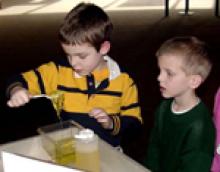
The goal of this demonstration is to explore the properties of a cross-linked polymer. When a polymer is cross-linked, it can take on new properties, such as going from a liquid to a solid.
Procedure
The goal of this demonstration is to explore the properties of a cross-linked polymer. When a polymer is cross-linked, it can take on new properties, such as going from a liquid to a solid.
Materials needed:
- 3 liter storage bottle of Alginic Acid solution
- 3 liter storage bottle of clear Calcium Chloride solution
- Food coloring for the Alginic Acid (green is a favorite with younger kids)
- Paper towels
- Large clear bowl
- 2 Squeeze bottles (one for the Alginic Acid solution and one for the Calcium Chloride Solution)
- Large plastic bag with a sealable top
- White Velcro strips with snaps on the ends
- Black Velcro discs (rough, "hook" side)
Procedure
Set-up: Macroscale
- Have the plastic bag, white Velcro strips and black Velcro disks available. The white Velcro strips should be un-snapped to allow the visitors to make the polymer chains. The black Velcro disks should be separated.
Set-up: Microscale
- Have the large plastic bowl and squeeze bottles of Alginic Acid and Calcium Chloride ready. Also, make sure there are paper towels available for clean-up.
Doing the Demonstration:
- Begin the museum show by finding out the museum guests' background of polymers. If there are visitors present that know what a polymer is, ask them to volunteer. Also, tell them they are going to make Gummiworms and ask how many of them like Gummiworms.
- Hold up the Velcro strips and explain that polymers are made of smaller molecules called "monomers." Ask the guests to make polymer chains about 4 or 5 monomers long and then place them in the plastic bag.
- Show the visitors the Alginic Acid and tell them that Alginic Acid is a polymer. What do they notice about the Alginic Acid? (It is a liquid)
- In order to make Gummiworms, you have to crosslink or "glue" the polymer chains together to make one very large polymer chain. The Calcium Chloride is the "glue" that will hold together all of the strands of polymer chains.
- Now, ask for volunteers to put the black Velcro disks into the bag with the white polymer chains.
- Close or seal the plastic bag and ask another guest to shake the bag. Before you open the bag, ask the guests what they think will happen if they try to pull out one polymer chain. (They will not be able to pull out one chain; they will all be stuck together).
- The next part of the demonstration is cross-linking on the Microscale.
- First, put the Calcium Chloride in the bowl or ask for a volunteer to put the Calcium Chloride in the bowl.
- Next, put the Alginic Acid in the bowl or ask for a volunteer to put the Alginic Acid in the bowl.
- Ask the guest to predict what would happen if you put your hand in the bowl, and then ask for a volunteer to put their hand into the bowl.
- They will pull out Gummiworms! At this point, you should allow other visitors to handle the Gummiworms. Also, you may want to point out that Gummiworms are solid and were made from two liquids.
Procedure Sheet: gummiworms_procedure.pdf
Gummi-worms FAQs
The word polymer can be broken into two parts, "poly" means many and "mer" means parts. A polymer is made of many parts called "monomers." Gummiworms are a particular type of polymer which has been "cross-linked." Cross-linked polymers chains are tangled together which makes them strong.
Cool Facts:
- Gummiworms are made by "tangling" polymer chains together; the more "tangles," the stronger the chain.
- Scientists use polymers to make carpet and some clothes that we wear.
It's not padding that keeps babies in disposable diapers dry, it's a polymer! Small polymers inside of diapers have the ability to hold water. - Silly Putty is a polymer, invented by an engineer in the 1940s. Originally called Nutty Putty, it can stretch to many times its original size!
- Some polymers can remember their shape. When you stretch a rubberband and release it, it goes back to its original shape.
- Certain polymers do not melt. Firefighters use these polymers in their equipment to keep themselves safe while they fight fires.
A: Not all cross-linked polymers are edible like gummiworms. Silly Putty is a cross-linked polymer and so are the rubber tires on a car. Cellulose is a natural cross-linked polymer that makes plants strong (it contains hundreds of "tangles".)
A: Silly putty is an elastic polymer which means it is a polymer that is able to remember its shape. When you stretch out something that is elastic, like a rubber band, the polymers stretch. When you let go, the substance snaps back to its original shape.
A: Diapers contain a polymer which absorbs water. This polymer can absorb about 50 times its weight inside of a diaper.
A: Some cross-linked polymers have very strong ties together. As a result, when the rubber gets hot, the rubber molecules cannot move past each other. This is why it doesn't melt.
Polymers influence much of technology. Cross-linked polymers are particularly useful because of their strength. In diapers, cross-linked polymers have the strength to hold water. Also, tires on cars can handle a lot of mileage without breaking down. Cross-linked polymers can even be heat resistant such as the polymers used to make a firefighter’s uniform.

